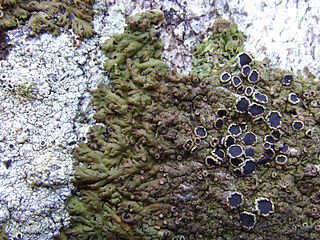Related Research Articles

The Coccotremataceae are a family of lichen-forming fungi in the order Pertusariales. Species in this widely distributed family grow on bark or rocks, especially in maritime regions.
Septotrapelia is a genus of lichen-forming fungi in the family Pilocarpaceae. It has four species. It was validly published as a genus in 2007 by lichenologists André Aptroot and Jose-Luis Chaves.

Anaptychia is a genus of lichenized fungi in the family Physciaceae.
Phaeochorella is a genus of fungi It was formerly placed in the family Phyllachoraceae, before in 2020 placed in the monotypic family of Phaeochorellaceae.
Eudarluca is a genus of fungi in the family Phaeosphaeriaceae. The genus was circumscribed by Italian-born Argentinian botanist and mycologist Carlo Luigi Spegazzini in 1908, with Eudarluca australis assigned as the type species.
Arecomyces is a genus of fungi in the family Hyponectriaceae.
Xenothecium is a genus of fungus in the family Hyponectriaceae; according to the 2007 Outline of Ascomycota, the placement in this family was uncertain. In 2020 it was confirmed. This is a monotypic genus, its only species being Xenothecium jodophilum. It was published by Franz Xaver Rudolf von Höhnel in Sber. Akad. Wiss. Wien, Math.-naturw. Kl., Abt. 1 vol.128 (7-8) on page 589 in 1919.
Apiorhynchostoma is a genus of fungi in the family Boliniaceae; according to the 2007 Outline of Ascomycota. The placement was confirmed in 2020.
Caudospora is a genus of fungi within the Diaporthales order, class Sordariomycetes. It was later placed in the Sydowiellaceae family.
Meliola is a large genus of fungi in the family Meliolaceae. It was circumscribed by Swedish mycologist Elias Magnus Fries in 1825.
The Asterinaceae are a family of fungi in the monotypic class Asterinales.
The Koralionastetaceae are a family of fungi in the Ascomycota phylum. This family was taxonomically classified into class of Sordariomycetes and order of Koralionastetales. It contained the genus Koralionastes and then PontogeneiaKohlm. was added later.

Candelaria is a genus of lichen-forming fungi in the family Candelariaceae. The genus was circumscribed by Italian lichenologist Abramo Bartolommeo Massalongo in 1852.
Spinulosphaeria is a genus of fungi in the Sordariomycetes class of the Ascomycota. It was placed in 2020, within the Order Coronophorales and in the family of Chaetosphaerellaceae.
Apodospora is a genus of fungi, formerly within the Lasiosphaeriaceae family. As on 2020, it was placed in the Bombardiaceae family.
Apodus is a genus of fungi that was originally placed within the Lasiosphaeriaceae family. In 2020 it was placed within the Neoschizotheciaceae family.
Jugulospora is a genus of fungi that was placed within the Lasiosphaeriaceae family, It was then moved into the Neoschizotheciaceae family. This was thought to be a monotypic genus, containing the single species Jugulospora rotula, until more species were found.
Zygopleurage is a genus of fungi, that was placed within the Lasiosphaeriaceae family. until later analysis placed it within the Neoschizotheciaceae family.
Himantormia is a genus of lichenized fungi in the family Parmeliaceae. The genus, which contains two species, is found in Antarctica. The genus was circumscribed by British lichenologist Elke Mackenzie in 1964.
Exserohilum echinochloae is a species of fungus in the family Pleosporaceae. Found in Bangladesh, where it grows on the leaves of Echinochloa colona, it was described as new to science in 1984. It is morphologically similar to Exserohilum monoceras and E. frumentacei, but differs from those species in its longer and wider conidia.
References
- ↑ Lumbsch TH, Huhndorf SM. (December 2007). "Outline of Ascomycota – 2007". Myconet. Chicago, USA: The Field Museum, Department of Botany. 13: 1–58.
- ↑ Wijayawardene, Nalin; Hyde, Kevin; Al-Ani, Laith Khalil Tawfeeq; Somayeh, Dolatabadi; Stadler, Marc; Haelewaters, Danny; et al. (2020). "Outline of Fungi and fungus-like taxa". Mycosphere. 11: 1060–1456. doi: 10.5943/mycosphere/11/1/8 .
- ↑ "Setomelanomma - Search Page". www.speciesfungorum.org. Species Fungorum. Retrieved 24 March 2023.